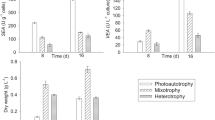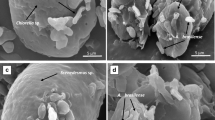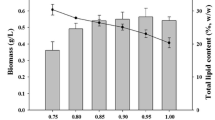Abstract
Microalgae present unexplored biotechnological potential and the ability to use different carbon sources in mixotrophic cultivation. Considering the need for efficient and low-cost industrial processes, the aim of this work was to evaluate the ability of microalgae and cyanobacteria to produce intra- and extracellular β-galactosidase. Eight species of Chlorophyta and Cyanophyta were cultivated in mixotrophic conditions with lactose as a carbon source. Dunaliella tertiolecta, Chlorella minutissima, and Nannochloropsis oculata were able to grow under mixotrophic conditions showing biomass production and growth rates higher than those of photoautotrophic cultures. β-Galactosidase extracellular production was 33.5 U L−1 on the 11th cultivation day for D. tertiolecta. For N. oculata and C. minutissima, the values were 29.6 and 11.02 U L−1 on the 14th and the 7th cultivation days, respectively. This study demonstrates the ability of microalgae to hydrolyze lactose under a mixotrophic regime and to outstanding great potential in the production of biomass and β-galactosidase.





Similar content being viewed by others
References
Abreu AP, Fernandes B, Vicente AA, Teixeira J, Dragone G (2012) Mixotrophic cultivation of Chlorella vulgaris using industrial dairy waste as organic carbon source. Bioresour Technol 118:61–66
Andersen RA, Berges JA, Harrisson PJ, Watanabe MM (2005) Recipes for freshwater and seawater media. In: Anderson RA (ed) Algal culturing techniques. Elsevier Academic Press, Amsterdam, pp 429–538
Angelo EA, Andrade DS, Filho AC (2014) Non-photoautotrophic cultivation of microalgae: an overview. Semina: Cienc Biol Saude 35(2):125–136
Benemann J, Woertz I, Lundquist T (2018) Autotrophic microalgae biomass production: from niche markets to commodities. Ind Biotechnol 14:3–10
Bentahar J, Doyen A, Beaulieu L, Deschênes J-S (2018) Investigation of β-galactosidase production by microalga Tetradesmus obliquus in determined growth conditions. J Appl Phycol. https://doi.org/10.1007/s10811-018-1550-y
Borowitzka MA (1988) Algal growth media and sources of cultures. In: Borowitzka MA, Borowitzka LJ (eds) Micro-algal biotechnology. Cambridge University Press, Cambridge, pp 456–465
Borowitzka MA (2013) High-value products from microalgae—their development and commercialisation. J Appl Phycol 25:743–756
Borowitzka MA, Siva CJ (2007) The taxonomy of the genus Dunaliella (Chlorophyta, Dunaliellales) with emphasis on the marine and halophilic species. J Appl Phycol 19:567–590
Brasil BSAF, de Siqueira FG, Salum TFC, Zanette CM, Spier MR (2017) Microalgae and cyanobacteria as enzyme biofactories. Algal Res 25:76–89
Brennan L, Owende P (2010) Biofuels from microalgae—a review of technologies for production, processing, and extractions of biofuels and co-products. Renew Sust Energ Rev 14:557–577
Carević M, Vukašinović-Sekulić M, Grbavčić S, Stojanović M, Mihailović M, Dimitrijević A, Bezbradica D (2015) Optimization of β-galactosidase production from lactic acid bacteria. Hemijska Industrija 69(3):7
Ceron Garcia MC, Garcia Camacho F, Sanchez Miron A, Fernandez Sevilla JM, Chisti Y, Molina Grima E (2006) Mixotrophic production of marine microalga Phaeodactylum tricornutum on various carbon sources. J Microbiol Biotechnol 16:689–694
Cheirsilp B, Torpee S (2012) Enhanced growth and lipid production of microalgae under mixotrophic culture condition: effect of light intensity, glucose concentration and fed-batch cultivation. Bioresour Technol 110:510–516
Chen G-Q, Chen F (2006) Growing phototrophic cells without light. Biotechnol Lett 28:607–616
Chojnacka K, Zielińska A (2012) Evaluation of growth yield of Spirulina (Arthrospira) sp. in photoautotrophic, heterotrophic and mixotrophic cultures. World J Microbiol Biotechnol 28:437–445
Dagbagli S, Goksungur Y (2008) Optimization of β-galactosidase production using Kluyveromyces lactis NRRL Y-8279 by response surface methodology. Electron J Biotechnol 11 (4)
Doran PM (2013) Material balances. In: Bioprocess engineering principles (Second Edition). Academic Press, London, pp 87–137
Gao C, Wang Y, Shen Y, Yan D, He X, Dai J, Wu Q (2014) Oil accumulation mechanisms of the oleaginous microalga Chlorella protothecoides revealed through its genome, transcriptomes, and proteomes. BMC Genomics 15(1):582
Girard J-M, Roy M-L, Hafsa MB, Gagnon J, Faucheux N, Heitz M, Tremblay R, Deschênes J-S (2014) Mixotrophic cultivation of green microalgae Scenedesmus obliquus on cheese whey permeate for biodiesel production. Algal Res 5:241–248
Guillard RRL (1975) Culture of phytoplankton for feeding marine invertebrates. In: Smith WL, Chanley MH (eds) Culture of marine invertebrate animals. Plenum Press, New York, pp 29–60
Guillard RR (2005) Purification methods for microalgae. In: Andersen RA (ed) Algal Culturing Techniques. Elsevier Academic Press, Amsterdam, pp 117–132
Heredia-Arroyo T, Wei W, Ruan R, Hu B (2011) Mixotrophic cultivation of Chlorella vulgaris and its potential application for the oil accumulation from non-sugar materials. Biomass Bioenergy 35:2245–2253
Husain Q (2010) β Galactosidases and their potential applications: a review. Crit Rev Biotechnol 30:41–62
Katoh S, Yoshida F (2009) Biochemical engineering: a textbook for engineers, chemists and biologists. Wiley-VCH, Germany
Li T, Zheng Y, Yu L, Chen S (2014) Mixotrophic cultivation of a Chlorella sorokiniana strain for enhanced biomass and lipid production. Biomass Bioenergy 66:204–213
McMillan JR, Watson IA, Ali M, Jaafar W (2013) Evaluation and comparison of algal cell disruption methods: microwave, waterbath, blender, ultrasonic and laser treatment. Appl Energy 103:128–134
Montalescot V, Rinaldi T, Touchard R, Jubeau S, Frappart M, Jaouen P, Bourseau P, Marchal L (2015) Optimization of bead milling parameters for the cell disruption of microalgae: process modeling and application to Porphyridium cruentum and Nannochloropsis oculata. Bioresour Technol 196:339–346
Neilson AH, Lewin RA (1974) The uptake and utilization of organic carbon by algae: an essay in comparative biochemistry. Phycologia 13:227–264
Odjadjare EC, Mutanda T, Olaniran AO (2015) Potential biotechnological application of microalgae: a critical review. Crit Rev Biotechnol 37:37–52
Panesar PS, Kumari S, Panesar R (2010) Potential applications of immobilized beta-galactosidase in food processing industries. Enzyme Research 2010:16
Perez-Garcia O, Escalante FME, de-Bashan LE, Bashan Y (2011) Heterotrophic cultures of microalgae: metabolism and potential products. Water Res 45:11–36
Pina-Pérez MC, Rivas A, Martínez A, Rodrigo D (2017) Antimicrobial potential of macro and microalgae against pathogenic and spoilage microorganisms in food. Food Chem 235:34–44
Pires JCM (2015) Mass production of microalgae. In: Kim S-K (ed) Handbook of marine microalgae. Academic Press, Boston, pp 55–68
Pulz O, Gross W (2004) Valuable products from biotechnology of microalgae. Appl Microbiol Biotechnol 65:635–648
Ribeiro JES, Martini M, Altomonte I, Salari F, Nardoni S, Sorce C, da Silva FLH, Andreucci A (2017) Production of Chlorella protothecoides biomass, chlorophyll and carotenoids using the dairy industry by-product scotta as a substrate. Biocatal Agric Biotechnol 11:207–213
Rizwan M, Mujtaba G, Lee K (2014) Influence of organic carbon sources on growth and lipid content of marine green alga Dunaliella tertiolecta. J Mar Biosci Biotechnol 6:68–75
Safi C, Camy S, Frances C, Varela MM, Badia EC, Pontalier P-Y, Vaca-Garcia C (2014) Extraction of lipids and pigments of Chlorella vulgaris by supercritical carbon dioxide: influence of bead milling on extraction performance. J Appl Phycol 26:1711–1718
Satyanarayana KG, Mariano AB, Vargas JVC (2011) A review on microalgae, a versatile source for sustainable energy and materials. Int J Energy Res 35:291–311
Shene C, Monsalve María T, Vergara D, Lienqueo María E, Rubilar M (2015) High pressure homogenization of Nannochloropsis oculata for the extraction of intracellular components: effect of process conditions and culture age. Eur J Lipid Sci Technol 118:631–639
Silaban A, Bai R, Gutierrez-Wing MT, Negulescu II, Rusch KA (2014) Effect of organic carbon, C:N ratio and light on the growth and lipid productivity of microalgae/cyanobacteria coculture. Eng Life Sci 14:47–56
Specifications CC (1981) Food chemical codex. National Academy Press, Washington
Stadler R, Wolf K, Hilgarth C, Tanner W, Sauer N (1995) Subcellular localization of the inducible Chlorella HUP1 monosaccharide-H+ symporter and cloning of a co-induced galactose-H+ symporter. Plant Physiol 107:33–41
Sukarni S, Hamidi N, Yanuhar U, Wardana ING (2014) Potential and properties of marine microalgae Nannochloropsis oculata as biomass fuel feedstock. Int J Energy Environ Eng 5:279–290
Velu P, Peter MJ, Sanniyasi E (2015) Effect of various carbon sources on biochemical production in marine microalgae Nannochloropsis salina (Eustigmatophyceae), Dunaliella tertiolecta (Chlorophyceae) and Tetraselmis suecica (Chlorodendrophyceae). Int J Curr Microbiol Appl Sci 4(3):8
Vieira Salla AC, Margarites AC, Seibel FI, Holz LC, Brião VB, Bertolin TE, Colla LM, Costa JAV (2016) Increase in the carbohydrate content of the microalgae Spirulina in culture by nutrient starvation and the addition of residues of whey protein concentrate. Bioresour Technol 209:133–141
Vu CHT, Lee H-G, Chang YK, Oh H-M (2018) Axenic cultures for microalgal biotechnology: establishment, assessment, maintenance, and applications. Biotechnol Adv 36:380–396
Wang D, Li Y, Hu X, Su W, Zhong M (2015) Combined enzymatic and mechanical cell disruption and lipid extraction of green alga Neochloris oleoabundans. Int J Mol Sci 16:7707–7722
Zhang C, Kim S-K (2010) Research and application of marine microbial enzymes: status and prospects. Mar Drugs 8:1920–1934
Zhang W, Zhang P, Sun H, Chen M, Lu S, Li P (2014) Effects of various organic carbon sources on the growth and biochemical composition of Chlorella pyrenoidosa. Bioresour Technol 173:52–58
Zheng H, Yin J, Gao Z, Huang H, Ji X, Dou C (2011) Disruption of Chlorella vulgaris cells for the release of biodiesel-producing lipids: a comparison of grinding, ultrasonication, bead milling, enzymatic lysis, and microwaves. Appl Biochem Biotechnol 164:1215–1224
Zhu CJ, Lee YK (1997) Determination of biomass dry weight of marine microalgae. J Appl Phycol 9:189–194
Author information
Authors and Affiliations
Corresponding author
Additional information
Publisher’s Note
Springer Nature remains neutral with regard to jurisdictional claims in published maps and institutional affiliations.
Rights and permissions
About this article
Cite this article
Zanette, C.M., Mariano, A.B., Yukawa, Y.S. et al. Microalgae mixotrophic cultivation for β-galactosidase production. J Appl Phycol 31, 1597–1606 (2019). https://doi.org/10.1007/s10811-018-1720-y
Received:
Revised:
Accepted:
Published:
Issue Date:
DOI: https://doi.org/10.1007/s10811-018-1720-y




